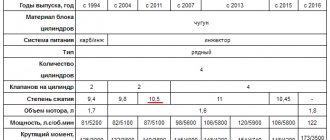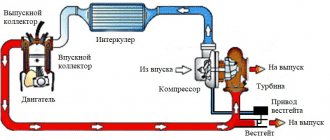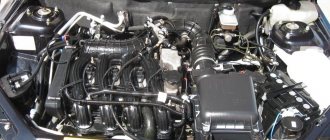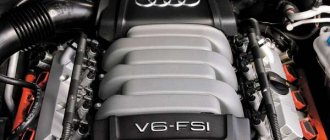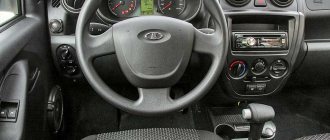Model review: VAZ 2104 without embellishment
Few people know that the VAZ 2104 (“four”) also bears the foreign name Lada Nova Break. This is a five-seater station wagon, which belongs to the second generation of AvtoVAZ “classics”.
The first models left the factory in September 1984 and thereby replaced the first generation station wagon - VAZ 2102. Although for another year (until 1985) the Volzhsky Automobile Plant produced both models simultaneously.
"Four" - the first station wagon in the VAZ line
VAZ 2104 cars were created on the basis of the VAZ 2105, only they had significant differences:
- extended rear part;
- folding rear bench;
- increased gas tank up to 45 liters;
- rear wipers with washer.
It must be said that the “four” were actively exported to other countries. In total, 1,142,000 VAZ 2104 units were produced.
Export model for the Spanish car market
Along with the VAZ 2104, its modification was also produced - the VAZ 21043. This is a more powerful car with a 1.5 liter carburetor engine and a five-speed gearbox.
Video: review of the Quartet
Reviews
Having “promoted” the so-called “Fiat” models, the “kopek” and the VAZ-2103 , to the required level, VAZ first slightly modernized the first one, releasing a modification of the VAZ-21011 , and then really began developing their own models - the all-wheel drive Niva, the “super-luxury” VAZ 2106 , as well as products of deeper intervention in the Fiat platform - we are talking about the “five” and VAZ-2107 . Let's not forget that by the beginning of the eighties, a fundamentally new model was almost completely ready - the first front-wheel drive hatchback VAZ-2108 . Thus, almost the entire model range was thoroughly shaken up for the new decade. And only the VAZ-2102 station wagon was produced without any special changes, although the base model 2101 was noticeably outdated by that time. There was no point in upgrading it “to level zero eleven” - the absence of fangs on the bumpers and a different number of vertical slats on the radiator grille would hardly have made the “kopeck piece” more modern. The conclusion suggested itself: the new station wagon model had to be produced on the basis of the most modern Zhiguli of the fifth family.
Specifications
A car in a station wagon weighs a little, only 1020 kg (for comparison: the “five” and “six” in a sedan body weigh more - from 1025 kg). The dimensions of the VAZ 2104, regardless of the configuration, are always the same:
- length - 4115 mm;
- width - 1620 mm;
- height - 1443 mm.
The base of the “five” was significantly improved and modified.
Thanks to the folding rear row, the trunk volume can be increased from 375 to 1340 liters, which made it possible to use the car for private transportation, country work and even small businesses. However, the back of the rear sofa does not fold entirely (due to the specific design of the car), so it is impossible to transport long cargo.
Trunk capacity can be easily increased with folding rear seats
However, long elements are easy to fix on the roof of the car, since the length of the VAZ 2104 allows you to transport beams, skis, boards and other long items without the risk of creating dangerous road situations. But you cannot overload the roof of the car, since the calculated rigidity of the station wagon body is much lower than that of sedans of the next generations of VAZ.
Transportation of goods is possible not only in the trunk, but also on the roof of the car
The total load on the vehicle (passengers + cargo) should not exceed 455 kg, otherwise damage to the chassis may occur.
The “Four” was equipped with two types of drives:
- FR (rear-wheel drive) is the basic equipment of the VAZ 2104. Allows you to make the car more powerful.
- FF (front-wheel drive) - selected models were equipped with front-wheel drive, as it is considered safer; subsequent versions of the VAZ began to be produced only in front-wheel drive.
Like other Lada representatives, the Four has a ground clearance of 170 mm. Even today, this is a completely reasonable ground clearance, allowing you to overcome major road obstacles.
Engine characteristics
Over the years, the VAZ 2104 was equipped with power units of different power: from 53 to 74 horsepower (1.3, 1.5, 1.6 and 1.8 liters). Two modifications (21048D and 21045D) used diesel fuel, but all other versions of the “four” consumed AI-92 gasoline.
The model was equipped exclusively with carburetor units
Depending on the engine power, fuel consumption also varies.
| Options | Fuel consumption, l/100 km | Fuel used |
| 1.8MT 21048D | 5,5 | Diesel fuel |
| 1.5MT 21045D | 8,6 | Diesel fuel |
| 1.6MT 21041 | 8,8 | Gasoline AI-92 |
| 1.3MT 2104 | 10,0 | Gasoline AI-92 |
| 1.5MT 21043i | 10,3 | Gasoline AI-92 |
| 1.5MT 21043 | 10,3 | Gasoline AI-92 |
The VAZ 2104 accelerates to a speed of 100 km/h in 17 seconds (this is a standard indicator for all VAZs produced in the 1980–1990s). The maximum speed of the machine (according to the operating instructions) is 137 km/h.
Table: parameters of the “four” motor
| Number of cylinders: | 4 |
| Cylinder displacement, l: | 1,45 |
| Compression ratio: | 8,5 |
| Rated engine power at a crankshaft speed of 5000 rpm: | 50.0 kW.- (68.0 hp) |
| Cylinder diameter, mm: | 76 |
| Piston stroke, mm: | 80 |
| Number of valves: | 8 |
| Minimum crankshaft speed, rpm: | 820–880 |
| Maximum torque at 4100 rpm, N*m: | 112 |
| Cylinder operating order: | 1–3-4–2 |
| Octane number of gasoline: | 95 (unleaded) |
| Fuel supply system: | Electronically controlled distributed injection |
| Spark plug: | А17ДВРМ, LR15YC-1 |
Injection engines. Reasons for failure
| VAZ 2104 engine: characteristics, features, types FF front-wheel drive, selected models were equipped with front-wheel drive, as it is considered safer; subsequent versions of the VAZ began to be produced only in front-wheel drive. This model is supported by its low loading height, body design with the ability to install an additional trunk, as well as its price and fairly reasonable technical characteristics. |
Design of diesel engines • The terms of cooperation assumed that the second enterprise would produce power units developed by VAZ.
Vehicle interior
The original interior of the VAZ 2104 has an ascetic design. All devices, parts and products are designed to perform their functions; there are no decorations or even a hint of any design solution. The task of the model's designers was to make a working car, suitable for passenger and cargo transportation, without focusing on comfort and beauty.
The interior contains the minimum necessary set of instruments and vehicle controls, standard upholstery in wear-resistant fabric and removable faux leather headrests on the seats. The picture is complemented by standard rubber mats on the floor.
The design of the Four's interior was borrowed from the base model, with the exception of the rear sofa, which was made foldable for the first time in the history of VAZ models.
Video: review of the Quartet’s interior
VAZ 2104 cars were discontinued in 2012. Therefore, even today you can meet amateurs who do not change their beliefs and use only time-tested and road-tested domestic cars.
The VAZ 2104 belongs to the “Classics” family of vehicles produced by AvtoVAZ. Many engines of this series were installed on the car, which makes them typical for this model range. The power units were remembered for their reliability and budget performance.
Specifications
The VAZ 2104 engine has typical technical characteristics of AvtoVAZ engines. In fact, vehicles of the 2104 model were equipped with power units of different markings, and the manufacturer did not produce an engine marked 2104. Thus, engines with the following markers were installed on the “four”: 2103, 2105, 21067, 21073 and 341. Let us consider in more detail the technical characteristics of each power unit:
VAZ 2103
| Name | Characteristic |
| Brand | 2103 |
| Type | Gasoline with the possibility of installing LPG |
| Injection system | Carburetor |
| Volume | 1.5 liters (1458 cm3) |
| Power | 80 hp |
| Number of cylinders | 4 |
| Number of valves | 8 |
| Consumption | 8.5 liters |
| Econorm | Euro 2 |
VAZ 2105
| Name | Characteristic |
| Brand | 2105 |
| Type | Gasoline with the possibility of installing LPG |
| Injection system | Carburetor |
| Volume | 1.3 liters (1290 cm3) |
| Power | 54 hp |
| Number of cylinders | 4 |
| Number of valves | 8 |
| Consumption | 9.2 liters |
| Econorm | Euro 2 |
VAZ 21067
| Name | Characteristic |
| Brand | 21067 |
| Type | Gasoline with the possibility of installing LPG |
| Injection system | Carburetor |
| Volume | 1.6 liters (1569 cc) |
| Power | 82 hp |
| Number of cylinders | 4 |
| Number of valves | 8 |
| Consumption | 8.5 liters |
| Econorm | Euro 2 |
VAZ 21073
| Name | Characteristic |
| Brand | 21073 |
| Type | Gasoline with the possibility of installing LPG |
| Injection system | Injector |
| Volume | 1.7 liters (1689 cc) |
| Power | 84 hp |
| Number of cylinders | 4 |
| Number of valves | 8 |
| Consumption | 9.5 liters |
| Econorm | Euro 2 |
VAZ 341
| Name | Characteristic |
| Brand | 341 |
| Type | Diesel |
| Injection system | Injector |
| Volume | 1.5 liters (1524 cm3) |
| Power | 50 hp |
| Number of cylinders | 4 |
| Number of valves | 8 |
| Consumption | 6.7 liters |
| Econorm | Euro 2 |
All engines in the series used a lightweight flywheel and a standard VAZ clutch. The 2104 engine was equipped with two types of gearboxes - a 4-speed and a 5-speed manual transmission.
Latest experiments
In 2007, Tema Plus installed an FNM engine on Chevrolet Niva for individual orders.
In 2014, on Lada 4x4 they experimented with 1.3 l 75 l. With. Fiat Multijet engine. However, it was not compatible with either the transmission due to torque limitations, or with the analog wiring diagram due to the CAN bus.
Super-auto explored the possibility of installing a 4x4 1.5 liter diesel engine from Renault Duster on the Lada 4x4 by 2015. In addition, an experimental car was created with a 100-horsepower 1.8 liter engine.
Service
Servicing VAZ engines, which are classified as “classics”, is quite simple, since the structure is the same, only the volume changes. According to the technical documentation, the service standard is 10,000 km. After this mileage, the engine needs to replace the lubricant and filter element.
In addition to standard maintenance procedures, other elements also change depending on the mileage. So, every 20,000 km the air filter is changed. Upon expiration. 40,000 km it is necessary to replace the gas distribution mechanism kit.
If the replacement is not done in a timely manner, the belt (or chain) may break, which will cause bent valves, and even worse, bending of the cylinder head or other consequences that will lead to premature overhaul.
Change of oil
Perhaps the most common and frequently performed repair operation is changing the oil and oil filter. Consider the sequence of actions:
- Before starting repair and restoration operations, you should remove the negative terminal from the battery.
- If there is engine protection, it must be removed. To do this, you need to unscrew the mounting bolts.
- Next, unscrew the drain plug, which is located on the pan, and wait for the lubricant to drain.
- We tighten the drain plug, while not forgetting to change the copper sealing gasket.
- Using a special puller, remove the oil filter. Before installing a new one, you need to pour 100 grams of new oil into it.
- Unscrew the filler neck and pour in the oil.
- After tightening the filler plug, start the engine and let it run for a few minutes.
- If necessary, add a little to the required level, which can be seen on the dipstick.
Thus, the oil change is considered complete. If the type of lubricant changes, the engine must be flushed.
Replacing the water pump
Another operation that motorists perform on classic engines is replacing the water pump. It is carried out mainly due to a faulty drive shaft bearing or when the gap increases and the water pump begins to leak. So, let's consider the sequence of actions aimed at troubleshooting:
- We dismantle the minus terminal of the battery.
- In order to dismantle the water pump, the drive belt must be removed. Depending on the design features, it can be connected to a common system or driven separately.
- The next step is to drain the coolant. To do this, you need to unscrew the radiator drain plug, first replacing the container. You can also drain the coolant using the drain hole on the block.
When replacing the pump, it is recommended to replace the coolant in the engine. It also has its own resource of use, and also gets dirty.
- Once all the coolant has been drained, you can begin replacing the water pump. Depending on the configuration, this unit can be secured with 3 or 5 bolts, which must be unscrewed, and then gently pull the product towards you.
- Installation is carried out in reverse order. At the same time, do not forget that it is necessary to change the gasket, which should come with the new pump.
- Pour coolant into the engine and start the car. Since there is air in the system, it must be removed from there. First, you should bleed the upper pipe and try to remove the maximum amount of air. The remaining amount will come out when the engine runs a little and circulation takes place. After the engine has been running, it is worth adding the coolant to the required level.
Niva.
VAZ Niva
At one time, the domestic manufacturer equipped the not little-known Niva with a diesel engine. The first diesel Niva VAZ was released with a domestic engine. This vehicle model had an engine displacement of one and a half liters and was equipped with a turbine. As a result, the model that came off the production line was not powerful enough. Since the domestic manufacturer produced the Niva to overcome difficult sections of the road, the engine power had to meet certain parameters. The domestically produced diesel engine could not cope with difficult sections of the road route and the manufacturer decided to increase the engine displacement. Further, cars with a volume of one point nine liters rolled off the assembly line of the Volga Automobile Plant. These diesel modernizations were installed on both three-door and five-door Niva. This engine model remained experimental and was not included in mass production.
After this, the manufacturer began to equip the domestic Niva with a foreign engine. The Peugeot diesel engine began to be serially installed on Russian cars. Engines from foreign manufacturers were more powerful and fully met the needs of domestic car enthusiasts. The Niva became more economical and fuel consumption met the required standards. Of course, after a diesel engine was installed on the Niva, the vehicle did not become more dynamic. The manufacturer set a speed limit of 120 kilometers per hour. In practice, a domestic car with a foreign engine reached a speed of 100 kilometers per hour only after a quarter of a minute. Some cars of this modernization can still be found on domestic roads. Moreover, most of the cars that have survived to this day are re-exported.
You can also often find a Niva with a self-installed diesel engine. Due to the efficiency of diesel, domestic car enthusiasts sometimes installed the engine with their own hands or in professional workshops. In most cases, the same engine from the Peugeot plant is installed on the Niva. This motor is the easiest to install in a vehicle system, since the points of contact with the body are completely similar to a gasoline engine. As you know, with such a modernization of a machine, replacing the engine alone is not enough. Along with replacing the motor, you have to disassemble the transmission and install a new gearbox. Most often, instead of a gearbox from a domestic manufacturer, a Fiat factory gearbox was installed. Accordingly, along with the modernization of the transmission, it was necessary to completely change the clutch housing. To optimize the operating temperature of the engine system, the craftsmen had to equip the vehicle with a GAZ radiator.
It is necessary to understand that modernization of the propulsion system requires appropriate registration with the traffic police!
Conclusion
The VAZ 2104 engine, or rather the modifications of AvtoVAZ power units that were installed on this car, are similar in technical characteristics, only during the development process the type of injection, volume and power changed.
As for service, it is typical and typical for all classic models. You can repair the engine with your own hands, without resorting to the services of a car service, which, in principle, is what most motorists do.
The domestic automobile industry is represented by many different models. However, in the history of AvtoVAZ there is one modification that even today causes the most controversial reviews. This is a VAZ 2104 equipped with a diesel power plant. Why was such an engineering move needed? Was it possible to create a car with clearer characteristics and power? What do the owners themselves think about the diesel version of the Four?
VAZ 2104 diesel
Diesel power plants are not typical for the domestic automobile industry. Therefore, the appearance of the VAZ 2104 with a diesel engine became a sensation. However, how successful can this modification be considered?
The VAZ 2104 was equipped with a VAZ-341 vortex chamber diesel engine. The engine was produced at the domestic enterprise JSC Barnaultransmash. Because of this device, AvtoVAZ engineers slightly changed the design of the car itself:
- installed a five-speed gearbox;
- connected a high-power radiator;
- increased the battery capacity to 62 Ah;
- developed a new form of starter;
- modified front suspension springs;
- increased sound insulation of the cabin.
At the same time, in practice, thanks to the use of a diesel unit, it was possible to significantly reduce fuel consumption, when, in all other respects, the diesel VAZ 2104 was in no way inferior to the gasoline one.
The diesel version has become significantly more economical than the gasoline version
The history of the VAZ diesel engine
The VAZ 2104 was first produced in Tolyatti in 1999. Initially, it was planned to equip the car with a more powerful 1.8-liter power unit, but this idea was never realized.
The new VAZ-341 diesel engine was characterized by high cost and reduced power. And even taking into account the low price of diesel fuel in 1999, the feasibility of such a modification was questioned by experts.
Diesel power unit 52 hp.
fits perfectly into the design of the “four” The VAZ-341 diesel engine was created in 1983. In fact, the new model was the result of modernization of the “three” engine. Engineers have significantly strengthened the existing cylinder block and piston stroke ratio. Due to many minor modifications, the VAZ-341 engine first began to be tested on cars only at the end of the 1999s.
Specifications
The engine on the VAZ 2104 (diesel version) consists of four cylinders arranged in a row. Engine displacement is 1.52 liters. As mentioned earlier, there were initially plans to install a 1.8 liter engine, but the tests failed. The power of the unit is only 52 horsepower. Initially, the diesel version of the VAZ 2104 was designed for beginners and leisurely drivers.
Low-power motor designed for city driving
The engine uses a liquid cooling system to operate.
An important difference from a gasoline installation is the additional equipment with a high-power starter and a modified block of glow plugs. This is necessary to ensure that the engine starts quickly in winter.
Thus, the VAZ-341 cannot be called a powerful power plant. However, it is precisely because of this that the car received the title of one of the most economical in the VAZ line: fuel consumption on the highway is only 5.8 liters, in an urban environment - 6.7 liters. Considering the low prices for diesel fuel at the turn of the 2000s, we can say that operating the model was not expensive.
The acceleration time to 100 km/h for the leisurely diesel VAZ 2104 is 23 seconds.
Manufacturers have also indicated the service life of the diesel engine - it requires major repairs every 150 thousand kilometers.
Even by modern standards, the thrust of the diesel “four” makes it competitive with many domestic and foreign brands
Peculiarities
The diesel station wagon differs in some design features from the gasoline VAZ-2104. Due to the greater mass, the diesel engine required the installation of reinforced front suspension springs. The main pair was replaced from 4.1 to 3.9. To compensate for the increased noise level from the diesel engine, additional sound insulation was installed in the engine compartment (on the hood and crankcase protection). The exhaust pipe was wrapped in a loop to prevent soot from contaminating the right canopy. An indicator for heating the glow plugs and a button for heating the fuel filter appeared on the dashboard (but there is no indicator for its activation).
Advantages of the VAZ-341 diesel engine
Why did manufacturers need to experiment with VAZ 2104 engines? The race among automakers at the turn of the 20th - 21st centuries led to the need for new modifications and developments in order to win “their” segment of buyers.
The main advantage of the diesel VAZ 2104 is its low fuel consumption, which, with minimal fuel prices, makes the car the most budget-friendly in the manufacturer’s line-up.
The second advantage of the model can be considered its reliability - the diesel engine and reinforced components made the car with increased performance. Accordingly, the owners did not need frequent repairs and specialized maintenance as needed to be done on the gasoline versions of the Four.
And the third advantage of the VAZ 2104 is the high engine thrust, even with a power of 52 horsepower. Therefore, the car is being purchased very actively:
- for country transportation;
- for use in large families;
- those who like to travel in large groups.
The model’s universal body is designed for cargo transportation, and with a diesel engine, the traction of a loaded vehicle increases significantly
And, of course, the VAZ-341 diesel engine can withstand Russian frosts perfectly. For example, the set temperature for a cold engine start is possible even at a temperature of minus 25 degrees. This advantage is very important for Russian drivers of all categories.
Differences from gasoline colleagues in the workshop
Changes have been introduced to the modification of the VAZ 2104 with a diesel engine.
- Additional sound insulation of the engine compartment.
- Strengthening the front springs of the suspension struts.
- The gear ratio of the main pair is reduced to 3.9.
- The exhaust duct is wrapped in a loop so as not to pollute the right rear light with soot (after all, the Euro 2 standard).
- The instrument panel is equipped with two elements: a fuel injection pump heating button and a glow plug temperature indicator.
The main difference lies in the technology itself for igniting the combustible mixture in the cylinder. Unlike the VAZ gasoline engine, the VAZ diesel engine does not mix air with fuel at the intake stage. At first, only air is started. Then, when it heats up to about 600 degrees and the piston rushes up, diesel fuel is injected.
The mixture ignites without the help of a spark from the spark plugs. VAZ diesel engines also have glow plugs. They help heat the air in the cylinder during the cold season so that it quickly reaches the optimal temperature and fuel is injected.
Under the hood of the VAZ 21045D there is a new device - a high-pressure fuel pump (HPF). This device is designed to resemble the engine itself. The drive is mechanical, not electric, like a gasoline pump. Using plungers, it pumps enormous pressure into the nozzles. A very important part of a diesel engine, it serves to maintain a pressure of about 100 kg/cm2 (almost 100 atm) in the engine power supply system.
The injector of the VAZ 2104 generation engine is also mechanical. Its main element is a needle, which rises under the pressure of diesel fuel and injects diesel fuel into the cylinder through thin channels. Since ignition in this case must occur without a spark, the dispersion of the fuel aerosol is significantly less than that of a VAZ 2104 injector or carburetor.
The engine layout is also different from gasoline cars. Under the hood, the unit is installed along the movement of the car. The compression ratio in the cylinder is 23, which is unattainable numbers for an injector and carburetor.
Disadvantages of the VAZ-341 diesel engine
Owners of diesel versions of the VAZ 2104 note several shortcomings of their cars:
- Difficulty in repairing the fuel system. Indeed, the use of low-quality fuel or neglect of the required level of maintenance quickly leads to the fact that the fuel injection pump fails. Its repair is possible only in specialized auto repair shops and is not cheap.
- When the timing belt breaks, the valves bend. That is, in case of an ordinary breakdown, you also have to spend money on buying new valves and adjusting them.
- High price. For all their efficiency in operation, VAZ 2104 diesel models are much more expensive than gasoline ones.
Valves are considered the weakest point of the model
